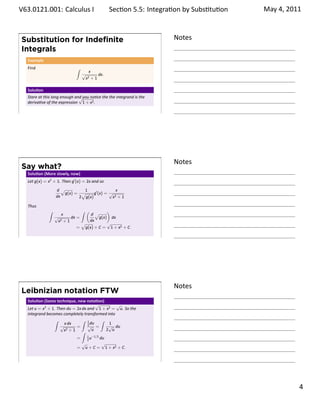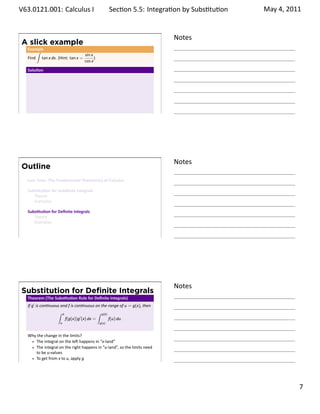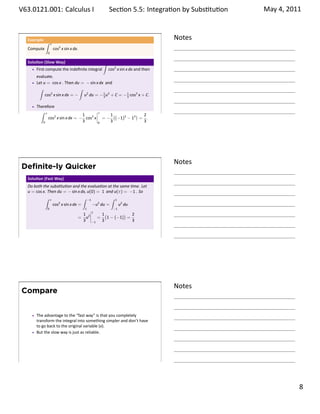Lesson 27: Integration by Substitution (handout)
- 1. . V63.0121.001: Calculus I . Sec on 5.5: Integra on by Subs . tu on May 4, 2011 Notes Sec on 5.5 Integra on by Subs tu on V63.0121.001: Calculus I . Professor Ma hew Leingang New York University May 4, 2011 . . Notes Announcements Today: 5.5 Monday 5/9: Review in class Tuesday 5/10: Review Sessions by TAs Wednesday 5/11: TA office hours: Adam 10–noon (WWH 906) Jerome 3:30–5:30 (WWH 501) Soohoon 6–8 (WWH 511) Thursday 5/12: Final Exam, 2:00–3:50pm . . Notes Resurrection Policy If your final score beats your midterm score, we will add 10% to its weight, and subtract 10% from the midterm weight. . . Image credit: Sco Beale / Laughing Squid . . 1 .
- 2. . V63.0121.001: Calculus I . Sec on 5.5: Integra on by Subs . tu on May 4, 2011 Notes Objectives Given an integral and a subs tu on, transform the integral into an equivalent one using a subs tu on Evaluate indefinite integrals using the method of subs tu on. Evaluate definite integrals using the method of subs tu on. . . Notes Outline Last Time: The Fundamental Theorem(s) of Calculus Subs tu on for Indefinite Integrals Theory Examples Subs tu on for Definite Integrals Theory Examples . . Differentiation and Integration as Notes reverse processes Theorem (The Fundamental Theorem of Calculus) 1. Let f be con nuous on [a, b]. Then ∫ d x f(t) dt = f(x) dx a 2. Let f be con nuous on [a, b] and f = F′ for some other func on F. Then ∫ b f(x) dx = F(b) − F(a). a . . . 2 .
- 3. . V63.0121.001: Calculus I . Sec on 5.5: Integra on by Subs . tu on May 4, 2011 Notes Techniques of antidifferentiation? So far we know only a few rules for an differen a on. Some are general, like ∫ ∫ ∫ [f(x) + g(x)] dx = f(x) dx + g(x) dx Some are pre y par cular, like ∫ 1 √ dx = arcsec x + C. x x2 − 1 What are we supposed to do with that? . . No straightforward system of Notes antidifferentiation So far we don’t have any way to find ∫ 2x √ dx x2 + 1 or ∫ tan x dx. Luckily, we can be smart and use the “an ” version of one of the most important rules of differen a on: the chain rule. . . Notes Outline Last Time: The Fundamental Theorem(s) of Calculus Subs tu on for Indefinite Integrals Theory Examples Subs tu on for Definite Integrals Theory Examples . . . 3 .
- 4. . V63.0121.001: Calculus I . Sec on 5.5: Integra on by Subs . tu on May 4, 2011 Substitution for Indefinite Notes Integrals Example Find ∫ x √ dx. x2+1 Solu on Stare at this long enough and you no ce the the integrand is the √ deriva ve of the expression 1 + x2 . . . Notes Say what? Solu on (More slowly, now) Let g(x) = x2 + 1. Then g′ (x) = 2x and so d√ 1 x g(x) = √ g′ (x) = √ dx 2 g(x) x2 + 1 Thus ∫ ∫ ( √ ) x d √ dx = g(x) dx x2 + 1 dx √ √ = g(x) + C = 1 + x2 + C. . . Notes Leibnizian notation FTW Solu on (Same technique, new nota on) √ √ Let u = x2 + 1. Then du = 2x dx and 1 + x2 = u. So the integrand becomes completely transformed into ∫ ∫ 1 ∫ x dx 2 du 1 √ = √ = √ du x2 + 1 ∫ u 2 u 1 −1/2 = 2u du √ √ = u + C = 1 + x2 + C. . . . 4 .
- 5. . V63.0121.001: Calculus I . Sec on 5.5: Integra on by Subs . tu on May 4, 2011 Notes Useful but unsavory variation Solu on (Same technique, new nota on, more idiot-proof) √ √ Let u = x2 + 1. Then du = 2x dx and 1 + x2 = u. “Solve for dx:” du dx = 2x So the integrand becomes completely transformed into ∫ ∫ ∫ x x du 1 √ dx = √ · = √ du x2 + 1 u 2x 2 u ∫ √ 1 −1/2 √ = 2u du = u + C = 1 + x2 + C. . Mathema cians have serious issues with mixing the x and u like this. . However, I can’t deny that it works. Notes Theorem of the Day Theorem (The Subs tu on Rule) If u = g(x) is a differen able func on whose range is an interval I and f is con nuous on I, then ∫ ∫ f(g(x))g′ (x) dx = f(u) du That is, if F is an an deriva ve for f, then ∫ f(g(x))g′ (x) dx = F(g(x)) . . Notes Theorem of the Day Theorem (The Subs tu on Rule) If u = g(x) is a differen able func on whose range is an interval I and f is con nuous on I, then ∫ ∫ f(g(x))g′ (x) dx = f(u) du In Leibniz nota on: ∫ ∫ du f(u) dx = f(u) du dx . . . 5 .
- 6. . V63.0121.001: Calculus I . Sec on 5.5: Integra on by Subs . tu on May 4, 2011 Notes A polynomial example Example ∫ Use the subs tu on u = x2 + 3 to find (x2 + 3)3 4x dx. Solu on If u = x2 + 3, then du = 2x dx, and 4x dx = 2 du. So ∫ ∫ ∫ (x2 + 3)3 4x dx = u3 2du = 2 u3 du 1 1 = u4 = (x2 + 3)4 2 2 . . Notes A polynomial example (brute force) Solu on ∫ ∫ ( ) (x2 + 3)3 4x dx = x6 + 9x4 + 27x2 + 27 4x dx ∫ ( ) = 4x7 + 36x5 + 108x3 + 108x dx 1 = x8 + 6x6 + 27x4 + 54x2 2 Which would you rather do? It’s a wash for low powers But for higher powers, it’s much easier to do subs tu on. . . Notes Compare We have the subs tu on method, which, when mul plied out, gives ∫ 1 (x2 + 3)3 4x dx = (x2 + 3)4 2 1( 8 ) = x + 12x6 + 54x4 + 108x2 + 81 2 1 81 = x8 + 6x6 + 27x4 + 54x2 + 2 2 and the brute force method ∫ 1 (x2 + 3)3 4x dx = x8 + 6x6 + 27x4 + 54x2 2 . Is there a difference? Is this a problem? . . 6 .
- 7. . V63.0121.001: Calculus I . Sec on 5.5: Integra on by Subs . tu on May 4, 2011 Notes A slick example Example ∫ sin x Find tan x dx. (Hint: tan x = ) cos x Solu on . . Notes Outline Last Time: The Fundamental Theorem(s) of Calculus Subs tu on for Indefinite Integrals Theory Examples Subs tu on for Definite Integrals Theory Examples . . Notes Substitution for Definite Integrals Theorem (The Subs tu on Rule for Definite Integrals) If g′ is con nuous and f is con nuous on the range of u = g(x), then ∫ b ∫ g(b) f(g(x))g′ (x) dx = f(u) du. a g(a) Why the change in the limits? The integral on the le happens in “x-land” The integral on the right happens in “u-land”, so the limits need to be u-values To get from x to u, apply g . . . 7 .
- 8. . V63.0121.001: Calculus I . Sec on 5.5: Integra on by Subs . tu on May 4, 2011 Example Notes ∫ π Compute cos2 x sin x dx. 0 Solu on (Slow Way) ∫ First compute the indefinite integral cos2 x sin x dx and then evaluate. Let u = cos x . Then du = − sin x dx and ∫ ∫ cos2 x sin x dx = − u2 du = − 1 u3 + C = − 3 cos3 x + C. 3 1 Therefore . ∫ π 1( ) 2 π 1 cos2 x sin x dx = − cos3 x =− (−1)3 − 13 = . . 0 3 0 3 3 Notes Definite-ly Quicker Solu on (Fast Way) Do both the subs tu on and the evalua on at the same me. Let u = cos x. Then du = − sin x dx, u(0) = 1 and u(π) = −1 . So ∫ π ∫ −1 ∫ 1 cos2 x sin x dx = −u2 du = u2 du 0 1 −1 1( ) 2 1 1 3 = u = 1 − (−1) = 3 −1 3 3 . . Notes Compare The advantage to the “fast way” is that you completely transform the integral into something simpler and don’t have to go back to the original variable (x). But the slow way is just as reliable. . . . 8 .
- 9. . V63.0121.001: Calculus I . Sec on 5.5: Integra on by Subs . tu on May 4, 2011 Notes An exponential example Example ∫ ln √8 √ Find √ e2x e2x + 1 dx ln 3 Solu on . . Notes Another way to skin that cat Example ∫ ln √8 √ Find √ e2x e2x + 1 dx ln 3 Solu on . . Notes A third skinned cat Example ∫ ln √8 √ Find √ e2x e2x + 1 dx ln 3 Solu on . . . 9 .
- 10. . V63.0121.001: Calculus I . Sec on 5.5: Integra on by Subs . tu on May 4, 2011 Notes A Trigonometric Example Example Find ∫ ( ) ( ) 3π/2 θ θ cot5 sec2 dθ. π 6 6 Before we dive in, think about: What “easy” subs tu ons might help? Which of the trig func ons suggests a subs tu on? . . Notes Solu on . . ( ) ( ) ∫ Notes Graphs ∫ 3π/2 θ θ π/4 cot5 sec2 dθ 6 cot5 φ sec2 φ dφ π 6 6 π/6 y y . θ φ π 3π ππ 2 64 The areas of these two regions are the same. . . . 10 .
- 11. . V63.0121.001: Calculus I . Sec on 5.5: Integra on by Subs . tu on May 4, 2011 ∫ ∫ Notes Graphs π/4 6 cot5 φ sec2 φ dφ √ 1 6u−5 du π/6 1/ 3 y y . φ u ππ 11 √ 64 3 The areas of these two regions are the same. . . Notes u/du pairs When deciding on a subs tu on, look for sub-expressions where one is (a constant mul ple of) the deriva ve of the other. Such as: √ u xn ln x sin x cos x tan x x ex 1 1 constant × du xn−1 cos x sin x sec2 x √ ex x x . . Notes Summary If F is an an deriva ve for f, then: ∫ f(g(x))g′ (x) dx = F(g(x)) If F is an an deriva ve for f, which is con nuous on the range of g, then: ∫ b ∫ g(b) f(g(x))g′ (x) dx = f(u) du = F(g(b)) − F(g(a)) a g(a) An differen a on in general and subs tu on in par cular is a “nonlinear” problem that needs prac ce, intui on, and perserverance. The whole an differen a on story is in Chapter 6. . . . 11 .


![. V63.0121.001: Calculus I
. Sec on 5.5: Integra on by Subs . tu on May 4, 2011
Notes
Objectives
Given an integral and a
subs tu on, transform the
integral into an equivalent one
using a subs tu on
Evaluate indefinite integrals
using the method of
subs tu on.
Evaluate definite integrals using
the method of subs tu on.
.
.
Notes
Outline
Last Time: The Fundamental Theorem(s) of Calculus
Subs tu on for Indefinite Integrals
Theory
Examples
Subs tu on for Definite Integrals
Theory
Examples
.
.
Differentiation and Integration as Notes
reverse processes
Theorem (The Fundamental Theorem of Calculus)
1. Let f be con nuous on [a, b]. Then
∫
d x
f(t) dt = f(x)
dx a
2. Let f be con nuous on [a, b] and f = F′ for some other func on
F. Then ∫ b
f(x) dx = F(b) − F(a).
a
.
.
. 2
.](https://image.slidesharecdn.com/lesson27-integrationbysubstitution001handout-110503222700-phpapp01/85/Lesson-27-Integration-by-Substitution-handout-2-320.jpg)
![. V63.0121.001: Calculus I
. Sec on 5.5: Integra on by Subs . tu on May 4, 2011
Notes
Techniques of antidifferentiation?
So far we know only a few rules for an differen a on. Some are
general, like
∫ ∫ ∫
[f(x) + g(x)] dx = f(x) dx + g(x) dx
Some are pre y par cular, like
∫
1
√ dx = arcsec x + C.
x x2 − 1
What are we supposed to do with that?
.
.
No straightforward system of Notes
antidifferentiation
So far we don’t have any way to find
∫
2x
√ dx
x2 + 1
or ∫
tan x dx.
Luckily, we can be smart and use the “an ” version of one of the
most important rules of differen a on: the chain rule.
.
.
Notes
Outline
Last Time: The Fundamental Theorem(s) of Calculus
Subs tu on for Indefinite Integrals
Theory
Examples
Subs tu on for Definite Integrals
Theory
Examples
.
.
. 3
.](https://image.slidesharecdn.com/lesson27-integrationbysubstitution001handout-110503222700-phpapp01/85/Lesson-27-Integration-by-Substitution-handout-3-320.jpg)







